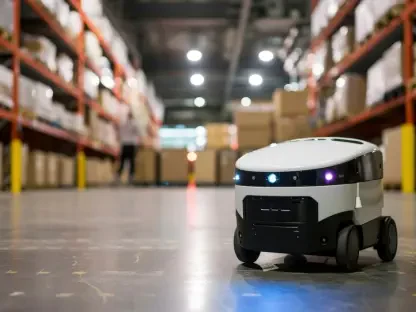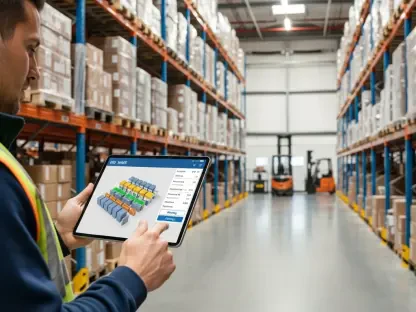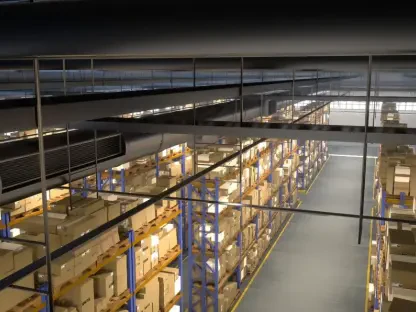The convergence of labor shortages and technological advancements has carved a new trajectory for the logistics sector. As businesses grapple with finding skilled workers to keep pace with demand, automation emerges as a transformative solution. This analysis delves into how automation is reshaping logistics through enhanced efficiency, new cost-effective solutions, and innovative regional approaches.
Rising Demand for Automation in Modern Logistics
In today’s rapidly evolving logistics landscape, the significant gap left by labor shortages demands immediate and innovative solutions. This vacuum has paved the way for increased reliance on automation. Serving as a robust countermeasure, automation not only addresses these workforce deficits but also propels the sector toward unprecedented efficiency. Examining automation’s far-reaching effects across logistics operations provides insights into its benefits and limitations. It enables operations to maintain continuity and productivity by optimizing resource allocation and minimizing reliance on manual labor.
Evolution and Industry Progress
The logistics sector has witnessed a substantial shift toward automation over recent decades, sparked by technological breakthroughs and evolving market demands. The transition from manual labor to automated processes offers a critical perspective on current industry dynamics. Key milestones, such as barcode scanning systems and automated sorting facilities, have acted as precursors to contemporary automation strategies. These advancements have ingrained automation as an indispensable component in logistics, providing a crucial solution for ongoing labor challenges.
Evaluating Automation’s Efficacy in Mitigating Labor Shortages
Data-Driven Efficiency Improvements
Automation plays a crucial role in enhancing operational efficiency amid labor shortages. Data reveals companies investing in robotic technologies experience increased throughput and accuracy. For instance, Amazon utilizes AI-driven forecasting to streamline supply chain management, allowing the reallocation of human resources to more value-oriented roles. However, despite these advantages, challenges persist, including high initial costs and potential job displacement concerns. Understanding these factors helps evaluate diverse perspectives on automation’s ability to sustain workforce requirements.
Cost-Effective Automation Innovations
A growing trend toward modular automation systems offers scalable and adaptable solutions for logistics. These systems allow businesses to implement automation without significant infrastructure changes, marking a shift in addressing labor shortages efficiently. Comparative analyses show that companies embracing modular systems realize significant cost reductions compared to traditional methods. Nevertheless, potential risks include technical challenges and integration complexities, necessitating careful evaluation of both opportunities and pitfalls.
Geographic Variations and Novel Adoption Models
Automation adoption rates vary greatly across regions, with Europe—particularly Germany—leading in robot installations. These regional disparities highlight differences in technology adoption and market strategies. Innovative models, such as the ‘Autonomous GO,’ permit firms to access automation based on usage rather than requiring substantial upfront investments. Understanding regional trends and dispelling job loss misconceptions underline automation’s role as a complement to human labor.
Future Directions: Anticipating Next-Generation Automation
Looking forward, advances in autonomous mobile robots and AI-driven platforms are expected to further redefine logistics operations. These innovations promise increased efficiency and reduced reliance on human labor. Regulatory changes, economic variables, and technological progress could significantly shape automation’s future in logistics. Industry experts anticipate sustainable automation solutions that address labor shortages while keeping the sector competitive through cutting-edge methodologies.
Strategic Pathways and Implementation Practices
Analyzing automation’s impact highlights strategic approaches for tackling labor challenges, such as integrating AI-driven systems and embracing modular platforms. These strategies are designed to boost productivity throughout logistics operations. Recommendations emphasize investing in workforce training programs to enable smooth transitions to automated systems. Stakeholders should develop actionable plans for implementing automation, fostering collaboration and adaptability to enhance logistics efficiency.
Final Reflections: Automation’s Influence on Logistics
This analysis has explored automation’s potential in resolving labor shortages in logistics, emphasizing its significance in achieving efficiency and cost-effectiveness while addressing challenges and dispelling myths. The ongoing relevance of this topic stems from persistent labor shortages and the sector’s dynamic technological evolution. As logistics moves further into automation, the necessity for strategic innovation and planning remains pivotal for success, ensuring technology and human labor work in harmony.









